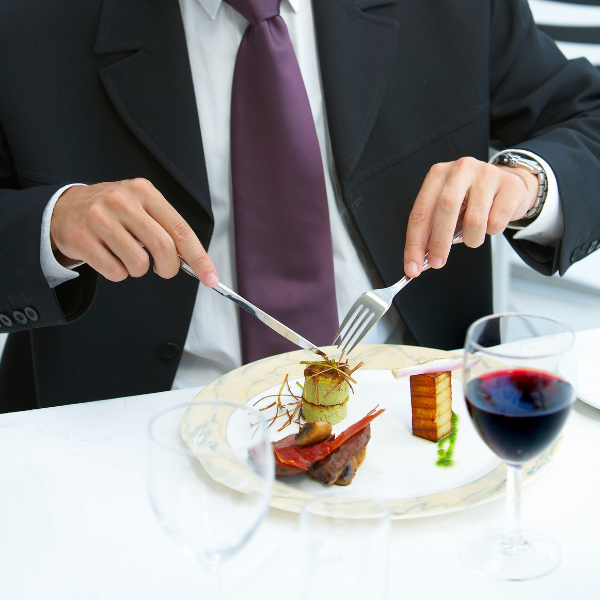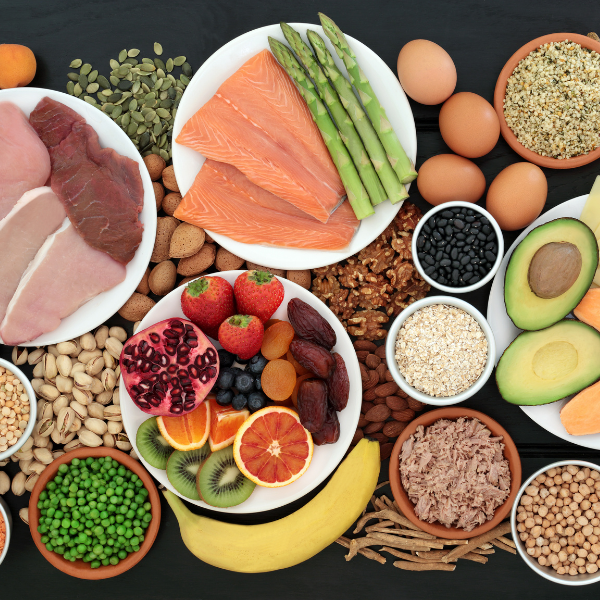The idea of sharpening your knives can be daunting if you don’t know where to start. While you can send your knives to be professionally sharpened, many people choose to sharpen them themselves. With many different methods and sharpeners to choose from, the decision on which knife sharpener you buy is based on personal preference and experience. In this comprehensive guide, we break down the basics of sharpening your knives and the different knife sharpeners available so you can choose the one that works best for you.
Why Sharpen Your Knives?
Knives are one of the most important tools in the kitchen, and it is essential to keep them sharp. A dull knife can be dangerous to use and can make completing tasks more difficult. When a blade’s edge — or bevel — isn’t properly sharpened, it can cause you more strain and effort to cut, slice, or dice your ingredients. In doing so, it could lead to the knife slipping and potentially causing an injury. Sharpening your knives regularly will help to keep them in good condition, making them safer and easier to use. Rather than getting rid of dull knives to buy new ones, you can save money by sharpening them and maintaining their condition.
When To Sharpen Your Knives
While it is important to maintain your knives and sharpen them when necessary, it’s just as important to ensure you’re not over-sharpening your knives. Knowing exactly when and how much to sharpen your knife can be tricky. The simplest answer is: whenever you notice your knife’s blade is dull or isn’t cutting properly. How often you sharpen your knife will depend on how often you use it. As a general rule of thumb; however, it’s best to sharpen your knives every few months. If you sharpen them too often, it will remove much of the metal, and the knife can wear out. A good way to maintain your knife’s blade in between sharpening is by using a honing rod or steel.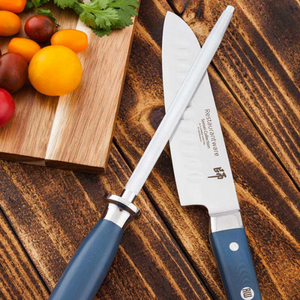
Different Kinds Of Knives
One of the most important steps in picking out a knife sharpener is understanding your knives. Not all sharpening methods work for all knives, so pairing your knife with the right sharpener is crucial. For example, Japanese-style knives have different angles in comparison to Western-style knives. Knowing which knife sharpener works best for your specific blade can help ensure that you purchase the right kind of sharpener to avoid ruining your knives or not properly sharpening the blades.
Different Types Of Knife Sharpeners
There are a number of ways to sharpen knives, and it is crucial to choose the method that best suits your needs. Some methods are more effective than others, and it is worth taking the time to find the one that works best for you. With so many different sharpeners on the market, it is worth knowing the difference to find the one that works best for you and your skill level.
Electric
Sharpening your knife with an electric sharpener is the most convenient of all the sharpening methods. Electric sharpeners are easy to use, require little effort, and don’t depend on previous knowledge of knife sharpening. They feature two or more slots or channels; they contain spinning sharpening stones on the inside that grind and sharpen the blade. Each channel is to make the blade sharper than the previous one, meaning they each have different levels of grit. To ensure you’re putting in your knife at the right angle — this depends on the blade you’re using — many electric knife sharpeners contain angle guides.
While electric sharpeners are extremely convenient, they do have some downsides. They are much bulkier than other sharpeners and can take up a lot of space on your kitchen countertop. Additionally, because they can leave you with a well-sharpened blade with little effort, they tend to be more expensive than other sharpeners. Electric sharpeners can also shorten the lifespan of your knife. If used too often or for too long, they can considerably take off more and more of the edge of your knife over time. You also won’t have as much control over your sharpening process, and you likely won’t learn many sharpening techniques.
Manual
Manual knife sharpeners are also often referred to as handheld or pull-through sharpeners. As the name implies, these sharpeners don’t utilize an automatic or electric system but require you to manually move the blade through the opening to sharpen. Manual or handheld sharpeners feature a D-shaped handle to hold the sharpener in place while in use, and usually one to three sharpening channels. The first channel is usually to sharpen the knives, with the other sharpening grooves having finer abrasives to either sharpen further or sometimes hone the blade. Their design can look similar to that of an electric sharpener, but a manual sharpener requires effort, whereas an electric one sharpens on its own.
Most handheld or pull-through sharpeners have preset angles, which helps if you are less experienced or still learning how to sharpen your knives. They’re easier to use than sharpening with a whetstone, although not as easy as an electric sharpener. However, the results aren’t always as accurate as other methods. They are smaller than electric sharpening tools, making them easy to store in a drawer or take on the go for traveling chefs. They are more affordable as well. Manual or handheld sharpeners are not good for knives with serrated edges. 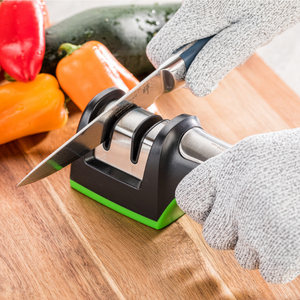
Whetstones/Sharpening Stones
Sharpening knives with whetstones or sharpening stones offers the most control than any other technique. There are different types of stones that can be used: some are used dry, some need to be submerged in water before use, and others need to be used with oil. It’s important to know when purchasing a sharpening stone which method it uses.
Sharpening stones are also the most difficult to use when it comes to sharpening knives. The stone is placed on a stable surface — many often come with a holder or a stand — and then the knife is run back and forth across the surface of the stone until it is sharpened. What’s unique about whetstones or sharpening stones is that because it is done completely by hand, you have to know the angle at which to hold your blade, as well as the sharpness for each knife. These stones often come double-sided, with one side being more coarse for sharpening and the other being a more fine side for refining the edge. A good-quality sharpening stone can last a long time, so you won’t have to worry about replacing it.
Because you have complete control over the sharpening process, many say that sharpening with a stone will produce the best results. That is, of course, when they are used properly. They do require a lot of learning and understanding to use, and they can also be time consuming. While manual or electric sharpeners may sharpen quicker, sharpening with a whetstone can take much longer.
Understanding The Grit Of Whetstones/Sharpening Stones
Many whetstones or sharpening stones will be double sided, with each side having a different grit. Each level of grit has a different function or purpose. By knowing the difference, you can be sure to sharpen your knife to precision.
- 1000 grit or lower: Coarse; used on blade with chips or knicks. Not recommended for general sharpening.
- 1000 to 3000 grit: Medium; used for regular or general knife sharpening.
- 4000 or higher: Fine or finishing stone; typically used for finishing or refining a knife’s edge. Achieves a fine or super fine finish, depending on the grit.
Honing/Sharpening Rods or Steels
These products have many names, including sharpening steels, sharpening rods, honing steels, knife hones, etc. The purpose of a honing steel is not to sharpen the blade, but rather to set a bent blade edge back into shape. To use a honing rod, you run the blade’s edge along the surface of the rod to realign the edge and straighten out any fibers that may have been bent during sharpening. A sharpening steel is used in between sharpening your knife to help maintain its edge and shape. In doing so, it will require less frequent sharpening and will extend your knife’s life. These rods are most often made of ceramic, steel, or diamond abrasives.
Similar to a sharpening stone, it is essential to know the angle at which you are honing your knife. Honing, although it is not to actually sharpen the knife, does require practice and precision. Because its purpose is to help maintain your blade’s edge and shape, it needs to be done correctly. 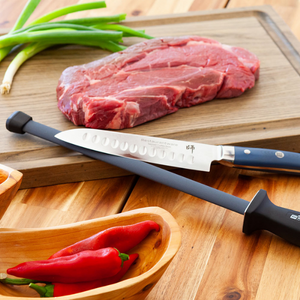
Blade Angles
The angle at which you sharpen or hone your knife is crucial. Each knife is different and can vary depending on the knife type or even the manufacturer. Some sharpeners may come with angle guides, which help you place the blade at the right angle while sharpening. For those that do not include guides, it’s vital to understand the angle at which you want to sharpen your knife.
The bigger the angle, the less sharp the blade becomes. And as the angle gets smaller, the knife’s bevel is much sharper. In general, most kitchen knives have around a 20-degree angle, around 10 degrees per side. Each knife’s purpose will determine the angle at which it should be sharpened. Below, we discuss the differences in angle degrees and which knives would be sharpened at which angles.
- 12- to 17-degree angle: These angles are very fine and are used for precise, fine cuts. Filet knives, sushi knives, or paring knives may be sharpened to this angle.
- 17- to 22-degree angle: This is the range where most kitchen knives live. Allow for sharp cuts without being too fragile or too thick. Used for chef’s knives, boning knives, carving knives, etc.
- 25- to 30-degree angle: Larger knives such as cleavers or other chopping blades have an angle in this range. These blades are stronger and much more durable, rather than more precise or sharp.
Stay Sharp!
Sharpening your knives regularly is an important part of kitchen maintenance. It is essential to keep them sharp for both safety and practicality. There are a number of ways to sharpen knives, and it is crucial to know the difference in how they work and which knives they work best with. By following this guide, you can make a knowledgeable decision when choosing the best knife sharpener for your needs!


